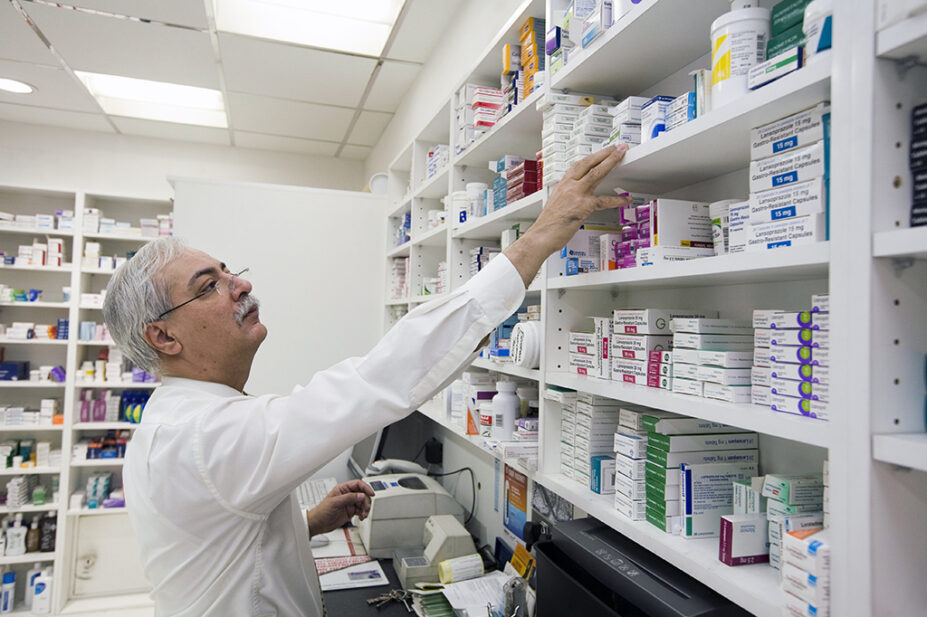
MARK THOMAS/SCIENCE PHOTO LIBRARY
A survey of more than 1,500 UK pharmacists has revealed the majority are still warning that medicine shortages have put patients at risk in the past six months, despite government efforts to try and mitigate problems.
The Pharmaceutical Journal’s salary and job satisfaction survey, which ran from 17 April to 1 May 2023, found that 902 out of 1,578 (57%) pharmacists working in all sectors of the profession answered ‘Yes’ when asked if medicines shortages have put patients at risk “in the past six months”.
This is a slight increase on the proportion of pharmacists (54%) who answered ‘Yes’ to the same question as part of The Pharmaceutical Journal’s survey in 2022.
The increase comes despite attempts by the Department of Health and Social Care (DHSC) to mitigate the impact of shortages on patients. In the year to May 2023, the DHSC has issued 23 serious shortage protocols (SSPs) for medicines facing supply problems, such as hormone replacement therapy (HRT) products and antibiotics.
SSPs, introduced in October 2019 as part of preparations for a ‘no-deal’ Brexit, allow pharmacists to respond to a medicines shortage by offering an alternative product specified in the protocol. However, pharmacists have described the protocols as “complex and time-consuming” to use.
In April 2022, the government convened a taskforce to secure supplies of HRT products to the UK, which later made recommendations to the DHSC in August 2022. The recommendations included continued use of SSPs and “continued dialogue” with HRT manufacturers.
Since April 2022, the government has issued 22 SSPs for HRT products, two of which are still active.
The Pharmaceutical Journal’s survey also found that, despite these measures, 15% of respondents are spending more than five hours per week on activities related to shortages, while a third are still unable to supply prescribed medicines to more than 10 patients per week because of shortages (see Box).
Respondents to the survey recounted numerous examples of medicines they were unable to provide to patients because of shortages, including HRT, atorvastatin, ramipril, alendronic acid and omeprazole.
“Many items out of stock; too many to list. In 40 years, it has never been so bad,” said one pharmacist.
Another pharmacist said that prescriptions for HRT and ADHD medications “have resulted in multiple Rx [prescriptions] only being partly fulfilled or not at all”.
“However, we try to find alternatives, but this does cause unnecessary delays as contacting [the] doctor, waiting for reply, getting a new Rx, explaining to the patient … causes the process to take a long time,” they said.
The findings follow increasing concerns around patient access to medicines facing supply issues, with data published by the Office for National Statistics in March 2023 showing that the proportion of people struggling to buy the medicines they needed had doubled since the previous year.
A roundtable on the issue of medicine shortages, hosted by The Pharmaceutical Journal in April 2023, concluded that pharmacy teams need timely and accurate information to mitigate the impact of shortages on patients, with community pharmacists given more flexibility beyond SSPs to make changes to prescriptions.
Gareth Jones, director of corporate affairs at the National Pharmacy Association (NPA), said: “Medicines shortages remain a frustrating fact of life for pharmacists. What adds to the stress is sometimes being blamed for something beyond your control.
“Thanks to the hard work of pharmacy teams, patients usually get what they need in time, but that’s not always possible,” he said.
“The NPA wants more flexibility for pharmacists to take decisions at the point of care to manage medicine supplies; for example, being able to amend prescriptions or share medicines among pharmacies. SSPs are useful but are not a complete solution.”
Gordon Hockey, director of legal at Community Pharmacy England, said medicines shortages are an “ongoing battle for community pharmacy teams and their patients”.
“Our own Pharmacy Pressures Survey this year found that almost all of the pharmacy staff surveyed reported that they are experiencing extra workload (97%) and additional stress (96%) due to supply issues,” he said.
“The situation shows little sign of improving after years of turbulence and, with patient safety at risk, the government urgently needs to step in and help stabilise the medicines market.”
Hockey added that pharmacists are “eminently qualified” to make simple changes to prescriptions “without the need for prescriber authorisation”.
“Hospital pharmacists have been doing this for years and community pharmacists should be similarly able to help patients,” he said.
A spokesperson for the Department of Health and Social Care said: “Community pharmacies play a vital role in the NHS, which is why we’re expanding the role they play in helping people access the care they need.
“We have well established procedures to deal with medicine shortages and work closely with industry, the NHS and others to prevent shortages to ensure patients continue to have access to the treatments they need.”
Box: Are medicine shortages impacting pharmacists’ ability to do their job?
When asked how many hours per week they spend “on activities related to medicine shortages”, 10% (157 of 1,570) of respondents to The Pharmaceutical Journal’s salary and job satisfaction survey said they spend ‘6 to 10’ hours per week on these activities. A further 2% (34) of respondents said they spend ’11 to 15’ hours per week, while 3% (44) of respondents said they spend ‘more than 15’ hours per week on activities related to shortages.
The survey also found that 33% (489 of 1,496) respondents reported being “unable to supply a prescription item because of medicine shortages” to more than 10 patients per week, on average. This included 261 respondents (17%) who said they are unable to supply an item to between 11 and 15 patients per week, and 228 respondents (15%) who said they are unable to supply to ‘more than 15’ patients because of shortages.


